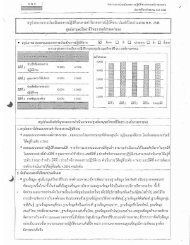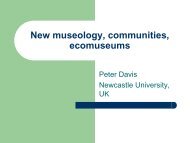Download
Download
Download
You also want an ePaper? Increase the reach of your titles
YUMPU automatically turns print PDFs into web optimized ePapers that Google loves.
The State and Ethnic Identity of the Phu Tai:A Case Study from Mukdahanby Sirijit SunantaDr. Sirijit Sunanta teaches in the Cultural Studies and Multicultural Studies Programs at the Research Institutefor Languages and Cultures of Asia, Mahidol University. She joined the Culture and Rights project in 2010 aftercompleting her doctoral degree in Women’s and Gender Studies from the University of British Columbia, Canada.When I started writing my proposal for the Cultureand Rights project in 2009, I had read a range of literatureon multiculturalism and cultural rights, mostly written byscholars placed in the Western world. Having been awayfrom Thailand for my graduate studies for more than sixyears, upon my return, I was surprised to learn that leadinginstitutions and scholars in Thailand were discussingcultural diversity, multiculturalism, and cultural rights, topicsI did not hear much of ten years earlier. Highland groupswho had formerly been known as chao khao (mountainpeoples) and chon klum noi (ethnic minority) had nowbegun organizing as indigenous peoples. The sense ofpolitical correctness and cultural sensitivity had begunto develop to the extent that groups such as chao khaowere now referred to as klum chatiphan (ethnic groups)rather than chon klumnoi, a pejorative term that signifiesnon-Thai groups who pose threat to the state. Thai stateagencies, following internationalorganizations and nongovernmentalorganizations,had started to make use of thevocabulary of cultural diversity,local wisdom, and communitybaseddevelopment (Connors2005), and the state had begunto allocate significant resourcesfor revitalizing local and ethnic cultures, supporting locallivelihoods, and regenerating local histories. I decidedI wanted to take part in the discussions and try tounderstand the shift towards a more inclusive notion ofThai national identity and a new emphasis on pluralizedand localized “Thai-ness.”Ban Phu: A Phu Tai VillageRecommended by a colleague, I chose Ban Phu,a village in Nong Sung District, Mukdahan Province, tostudy local understandings and implications of culturalrights in the Thai context. Consisting of 250 households, thevillagers of Ban Phu are mostly related to each other andare of the Phu Tai ethnic group, one of the major ethnicgroups in northeast Thailand. Ban Phu is known as anoutstanding model for community development projectsand has won a number of titles in this regard. Morerecently, the village has also been chosen as a sitefor community culture projects. In 2009, the Bank forAgriculture and Agricultural Co-operatives nominatedBan Phu as a Model Sufficiency Economy VillageLevel 3; the village received a cash award fromMukdahan’s Wattanatham Thai Sai Yai ChumchonProject the same year.The Phu Tai,who speak a Tai languagethat differs from the Thai-Lao language spokenby the majority of thepopulation in the northeastand from Central Thai,the national language ofThailand, are recognizedas a klum chatiphan, or an ethnic group, in Thailand.Entitled to full Thai citizenship rights, the Phu Tai inNortheast Thailand today are descendants of Phu Taimigrants forced to move from the west side of the MekongRiver during the war between Siam and King Anu ofVientiane in the first half of the nineteen19th century. They“I found that decades of staterural development policies andthe prevalent localism discoursehad significantly shaped the waythe Phu Tai in Ban Phu relateto their ethnic identity and theirunderstanding of citizenship today.”







